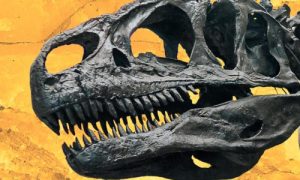 It’s a 2-day dinosaur extravaganza, featuring life size-cast skeletons of some of the most iconic dinosaurs of the Mesozoic Era, a wide variety of dinosaur fossils, dino-themed activities and crafts, the opportunity to interact with expert paleontologists, and the chance to experience museum’s newest special exhibit Dinosaur Discoveries: Ancient Fossils, New Ideas.
It’s a 2-day dinosaur extravaganza, featuring life size-cast skeletons of some of the most iconic dinosaurs of the Mesozoic Era, a wide variety of dinosaur fossils, dino-themed activities and crafts, the opportunity to interact with expert paleontologists, and the chance to experience museum’s newest special exhibit Dinosaur Discoveries: Ancient Fossils, New Ideas.
The Dino Festival take place at the Virginia Museum of Natural History (VMNH) on Friday, July 21 and Saturday, July 22, from 10 a.m. to 4 p.m. each day. Admission rates apply.
Life-size cast skeletons and skulls will be featured.
Triceratops
A large, plant-eating dinosaur distinguishable by its large frill and three horns that lived during the Late Cretaceous period, from approximately 68 to 66 million years ago
Stegosaurus
A large, plant-eating dinosaur distinguishable by two rows of bony plates on its back. It lived during the Late Jurassic period, from approximately 155 to 150 million years ago
Acrocanthosaurus
A massive, carnivorous theropod dinosaur that existed in what is now North America during the Early Cretaceous period, from approximately 125 million to 100 million years ago
Allosaurus
A large, carnivorous theropod dinosaur of the Late Jurassic period, from approximately 155 to 150 million years ago
Platecarpus Tympaniticus
A 17 foot long cast skeleton of a massive sea-going reptile that lived 81 to 84 million years ago during the Cretaceous period. This animal, a species of mosasaur, once swam in waters that covered what is now the central United States!
Tyrannosaurus rex (skull)
One of the most iconic dinosaurs of all time, T. rex was a large carnivorous dinosaur that lived in what is now western North America approximately 68 to 66 million years ago
Dromaeosaurus (skull)
A medium-sized carnivorous dinosaur and a very close relative of the famous Velociraptor that lived in what is now the western United States and Alberta, Canada during the Late Cretaceous from approximately 77 to 74 million years ago
Albertosaurus (skull)
A genus of tyrannosaurid theropod dinosaurs that lived in western North America during the Late Cretaceous Period, from approximately 70 million years ago
Edmontosaurus (skull)
A genus of duck-billed dinosaur that lived in western North America during the Cretaceous Period approximately 73 to 66 million years ago.
Dunkleosteus (skull)
An armored fish from a group of fish called placoderms that lived approximately 360 to 380 million years ago.
Tylosaurus (skull)
A gigantic, sea-going relative of lizards, Tylosaurus was one of the biggest ocean predators ever to live. With a skull almost six feet long, a body over forty feet, and a mouth full of pointed teeth, it could pretty much eat whatever it wanted, from fish to other giant lizards.
Dinosaur Fossils Galore will be among the exhibits.
See original dinosaur bones from the collections of VMNH! Since the 1990s, VMNH research teams have been digging for 150-million-year-old dinosaur bones in Wyoming. Over that time, they’ve collected parts of long-necked sauropods, the plated Stegosaurus, and the predatory giant Allosaurus! Dino Tracks!
Dinosaur footprints have been found in the hundreds across Virginia, from the far north to the southern border near Danville. See original tracks of three-toed carnivorous dinosaurs—over 200 million years old– from across the Commonwealth.
Festivities Abound, with face painting, balloon animals, food trucks, and a host of dino-themed children’s activities and crafts will take place both days of the event. Stop by the Museum Store to browse the special collection of dino-themed items for sale or capture a memory of your adventure at the Dino Fest Photo Booth.
Experience the museum’s newest special exhibit Dinosaur Discoveries: Ancient Fossils, New Ideas.
Using a combination of major fossil finds, captivating computer simulations, and provocative models, Dinosaur Discoveries: Ancient Fossils, New Ideas introduces a dynamic vision of dinosaurs and the scientists who study them. The exhibit examines, in great detail, recent scientific sleuthing and the array of investigative tools—from bioengineering computer software to CT scans—used by modern scientists to reinterpret many of the most persistent and puzzling mysteries of dinosaurs: what they looked like, how they behaved, and how they moved. It also explores the complex and hotly debated theories of why—or even whether—they became extinct.
Dinosaur Discoveries: Ancient Fossils, New Ideas is organized by the American Museum of Natural History, New York (www.amnh.org), in collaboration with the California Academy of Sciences, San Francisco; The Field Museum, Chicago; the Houston Museum of Natural Science; and the North Carolina Museum of Natural Sciences, Raleigh.
The event includes on-site food options. Admission prices are $10/Ages 18-59; $5/Ages 3-17; $5/Seniors 60+.
Admission is FREE for children under 3; FREE for VMNH Members; FREE for members of ASTC Passport participating institutions; FREE for EBT card holders who present their EBT card and official photo ID.
Groupons are accepted.
**Admission is available at the door. Paying attendees on Friday will be allowed to experience the event again on Saturday at no additional charge. All Dino Festival offerings and information listed is subject to change.**
****This year’s event will take place indoors and outdoors. Parking for this event will take place off-site and free of charge. Additional parking information, including a list of suggested parking lots and a parking map, will be posted in the days leading up to the festival.****



